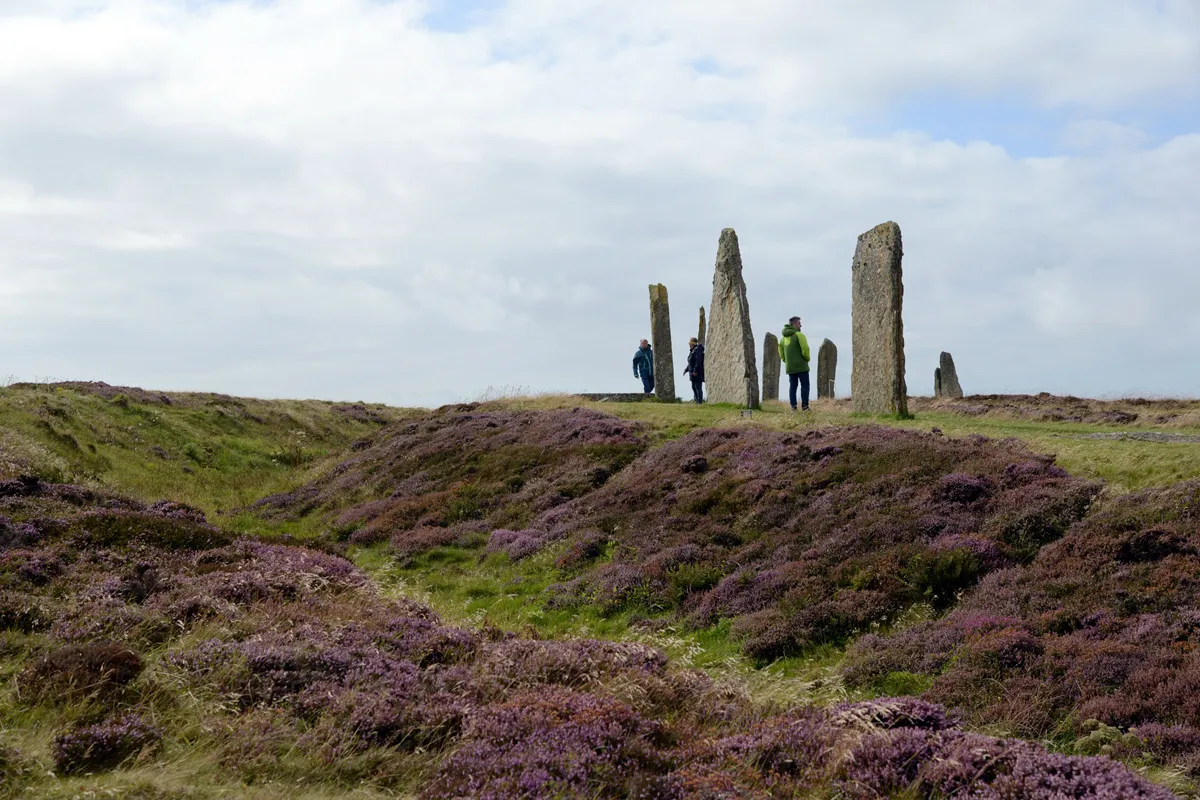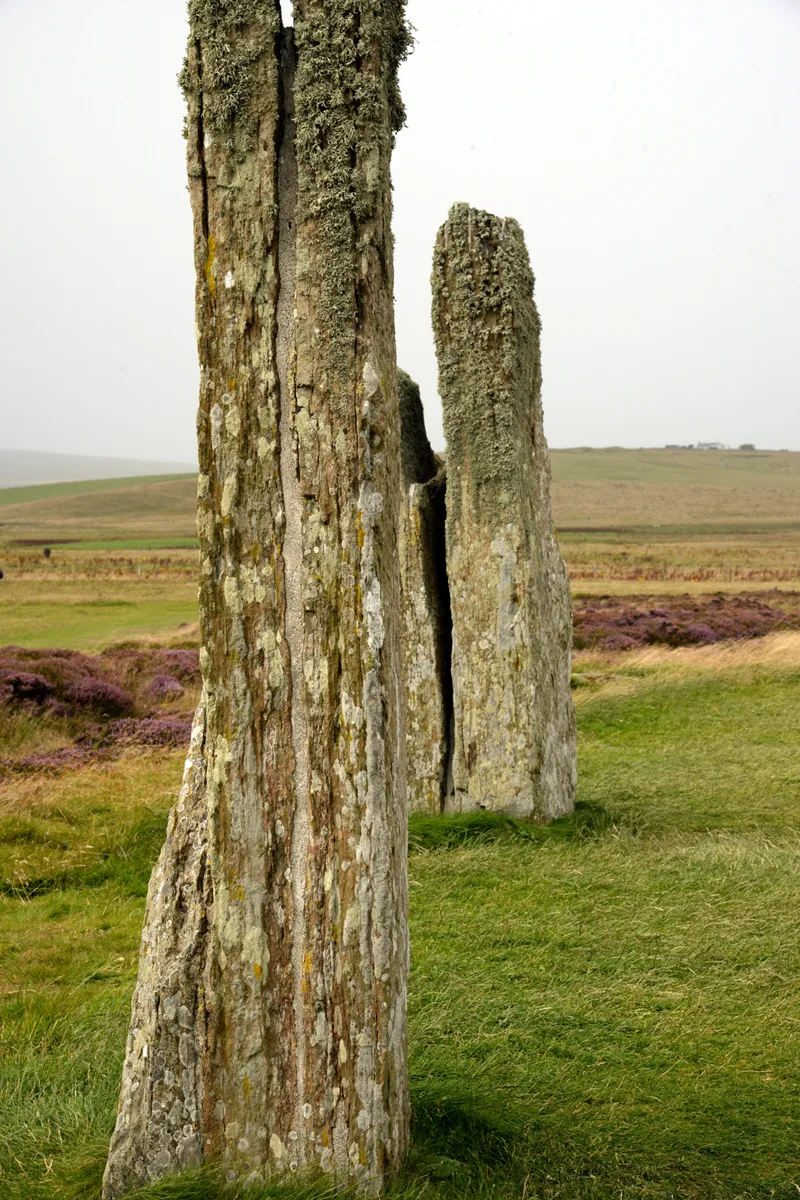
Orkney - a tiny group of islands just north of Scotland have a history that shows the islands have been inhabited since the Stone Age. Two years ago, I visited the islands, which have a close connection to Norway. The vikings established settlements here about 1000 years ago. Our first day was spend exploring the time of Norse rule in Kirkwall, the main town. Second day we went as far back as to the Stone Age to discover the UNESCO World Heritage Site called «The Heart of Neolithic Orkney». Since mid 1900s quite a large number of settlements from the Stone Age has been reveiled. Massive stone circles, tombs and villages, especially on the Mainland (which is the largest island).
That morning we got up early in order to catch a local bus to Skara Brae, Ring of Brodgar and Standing Stones of Stenness. The bus ticket was a day ticket, so we could get off and on several times.

Skara Brae
We went to Skara Brae first. This is a 5000 year old Stone Age settlement situated by the Atlantic Ocean. There is a visitor center here, which has a cafe, shop and a small museum, which was great for us. Because of rain and increasing wind we needed a place to wait untill the bus returned 4 hours later.



However, we took the trip to the excavation site first. We literally went back in time from our time reckoning to 3100 BC. Along the path there are signs showing a year and what characterizes that year historically. The first is "1969 first man on the moon" etc. until we stood at the year 3100 BC at the entrance to the Stone Age.




The village is the best preserved of its kind in Europe, inhabited for a period between 3100 BC to about 2600 BC. Informative posters and a reconstructed house give a good impression of what it once looked like and how people lived. The village was not discovered before in 1850 after a storm. Until then it had been burried under sand, but the storm blew some of that away, revealing the houses.

Skaill House
The wind increased all the time and we had to take good care not to lose our balance. Since we had plenty of time and Skaill House was included in the entrance ticket, we went up there as well.




This place was the home of the man who discovered Skare Brae – William G. Watt. The house itself was built in 1620. Renovated and reopned to the public. For 400 years it has been a house of significance in the Orkneys. The items in the house has been collected by 12 Lairds of Skaill since the 17th century. Beautiful house, but hard to imagine people living in such an isolated place.

Ring of Brodgar
The bus drove the same way back towards Kirkwall, but we got off at the Ring of Brodgar, located between two lakes on a narrow strip of land. The circle of stones stands on a hill with views in all directions. There is no visitor center and nowhere to find shelter from the wind, except behind the standing stones.


This ancient stone circle is from the same era as Skara Brae - built around 3000 BC. By comparison, the pyramids in Egypt were built in the period 2600 - 1600 bc (acording to Wikipeida). This stone circle is the largest stone circle in Scotland - larger than Stonehenge.


The wind had increased and in between it rained. The large tour groups arrived and left quickly, leaving the place to ourselves. Quite an amazing feeling. The wind, the rain and clouds added some drama too. But we did get a glimpse of sun and blue sky, even it didn't last for long.


The circle is about 100 m. in diameter with a ditch surrounding the circle. The stones are more than 2 m. high, standing upright. It it assumed that there has been 60 standing stones, but today only 27 ( I read that). It must have been an organized society with some skills in order to be able to built a monoment as big as this. The location was regarded a sacred site. The surrouding landscape is dotted with mounds containing tombs. It was probably a huge ceremonial complex and might even have been connected with the Stones of Stenness. We could see those stones from here.

Standing Stones of Stenness.
We had to stay here for more than 3 hours, in order to wait for the bus. It gave us plenty of time, but we chose to walk down to Standing Stones of Stenness, which is only a couple of kilometers walk, then take the bus from there.


This site has only three stones left and the tallest is about 5 m. high. It assumed there has been 12 originally.
Back to reality and our own time ... we lost the bus ! No where to hide for the wind so we walked to the main road and sat down behind a 50cm. high stone fence. But when the bus from Kirkwall going to Stromnes came, we got on. After all we had a day ticket and was better to sit on the bus, even it ment a detour before going back to Kirkwall. If we ever go again, we have to consider renting a car. The busses aren't frequent. But an adventurous day never the less.

Our first day in Kirkwall:
Scotland – How to spend a day in Kirkwall (Orkney)
Please do follow if you want to keep up with my next travel story. Any upvotes or resteems are hugely appreciated!
Latest travel stories, check out :
STREET ART #79 - Tropical theme in Chinatown (Mauritius)
U.J
Kristiansand, Norway
All the photoes are mine, Ulla Jensen (flickr, Instagram and facebook)
[//]:# (!pinmapple 58.982163 lat -2.961895 long Scotland – Taking a step 5000 years back in time (Orkney, part two) d3scr)
Read about us? // Main page!
Latest content: Travel, Art, Food, Article, Poetry



























